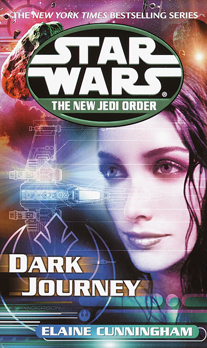Rey from “The Force Awakens” has gotten a lot of hype as a breakthrough female Jedi, but as fans of the Legends canon know, Rey had many predecessors. Perhaps the most richly characterized was Jaina Solo, and the book that focuses on her the most is “Dark Journey” (2002), the 10th novel in the “New Jedi Order” series, placing it exactly in the middle of the 19-book saga.
I didn’t remember a lot about this book, the only “Star Wars” novel by Elaine Cunningham. Upon its release, it might have read like an understated side trip. In the previous entry, “Star by Star,” Anakin dies, Jacen goes missing and Coruscant falls to the Yuuzhan Vong. “Dark Journey” takes place entirely in the Hapes Cluster, with a couple of Vong – the priest Harrar and the warrior Khalee Lah – obsessed with capturing Jaina, who blasphemes their god by declaring her stolen Vong ship (and herself, by extension) “the Trickster.”
On a second read, without feeling a pressing need to get answers about Jacen’s fate and what’s happening to the capital planet, “Dark Journey” is an outstanding character piece for Jaina. Whereas “Star by Star” was a literal journey into darkness, “Dark Journey” has a more pleasant outward atmosphere because it takes place entirely in the (relatively) friendly Hapes Cluster. The title refers more to Jaina’s inner journey. I had forgotten how much she flirts with – and outright engages in – the dark side, and I think the reason is because her arc doesn’t follow the usual “Star Wars” clichés.
“Tales of the Jedi’s” Ulic Qel-Droma and “Dark Empire’s” Luke Skywalker are consumed by the dark side after wrongly assuming they can resist its lure. But Jaina engages in dark activities, notably capturing a coral-implanted Peace Brigader to be experimented on, and is always cognizant of what she is doing. She knows she is using the dark side, but her goal is always to defeat the Vong, never personal power, and that might be why she remains stronger than Ulic or Luke. It’s also why a reader is never truly worried that she’ll fall to the dark side.
Similarly to Rey, a palpable confidence backs all of Jaina’s actions here. The difference is that there’s a tint of darkness and anger behind her actions, which a reader can sense because she is ALL action. She’s not taking time to mourn her brothers; she’s focused on the fight. While this might lead to an emotional breakdown in a future book, “Dark Journey” does play like 18-year-old Jaina is crossing the threshold into adulthood.
Unlike the movies, the “hero’s journeys” of book characters aren’t confined to a specific adventure; indeed, Jaina’s journey dates back to the “Young Jedi Knights” books. Still, “Dark Journey” feels like the definitive coming-of-age novel for Jaina Solo. (Part of why the cancellation of the EU hurts so much is that the next trilogy, Christie Golden’s “Sword of the Jedi,” would’ve been the next major Jaina arc, featuring the character in her 30s.)

In a parallel to “The Empire Strikes Back” and “The Force Awakens,” Jaina experiences one of the more fascinating Force visions of the whole saga (page 280). She sees herself fighting Jacen, an event that actually does happen in the “Young Jedi Knights” books, when the twins are tricked into dueling by their Shadow Academy teachers. But is this merely a flashback, or is it a sneak preview of the “Legacy of the Force” saga, where Jacen turns evil? Darth Vader’s mask reveals Jacen beneath, which is quite a twist in a book about Jaina flirting with the dark side and also when one considers that Jacen questions the morality of using the Force at all.
Kyp Durron, whom Jaina accepts as her Jedi Master here, for his part is on a journey similar to the title character from “Angel.” He killed 25 million people when he destroyed Carida with the Sun Crusher in the “Jedi Academy Trilogy,” and now he seeks to do good to atone for that crime – even though he knows the scales can’t be completely balanced. But as the captain of an X-wing flight, he aggressively uses his pilots as chess pieces, sometimes even sacrificing them, opening up questions of how far a Jedi should go to save the galaxy. After the “Jedi Academy Trilogy,” Kyp is never a main character again, but on this re-read of the “NJO,” he has snuck up on me as a great supporting player.
The Kyp-Jaina relationship leads to good exchanges of dialogue (as well as a truncated lightsaber duel that isn’t necessary), but Cunningham does her most subtle work in building up the Jaina-Jag relationship, which will later become a romance. Both Jaina and 20-year-old Jagged Fel, a human pilot for the Chiss Ascendency (an ally of the Imperial Remnant), are unaware that their behavior is influenced by the fact that they are smitten with each other, but a reader can see it. As Jaina displays an oblivious edge that she probably gets from her father, Han, Cunningham has an appealingly light touch in portraying this budding romance. A reader is exasperated by and fascinated by Jaina at the same pace as poor Jag.
“Dark Journey” is also the book where Tenel Ka (more or less Jacen’s girlfriend at this point, and the future mother of Jacen’s child, Allana Solo) assumes the throne of the Hapes Cluster, a position she’ll hold throughout the novels from this point forward. I had forgotten that the manipulative former Queen Mother, Ta’a Chume (Tenel Ka’s grandmother) initially attempts to get Jaina to marry Isolder and assume the throne, a repeat of the scheme she tried on Princess Leia back in “The Courtship of Princess Leia.” There’s never any chance that Jaina will accept the proposal, because Cunningham does such a nice job of showing us a complete portrayal of who Jaina is and what her values are.
This 301-page paperback is a refreshingly brisk read, coming on the heels of the bloated, intimidating “Star by Star.” It’s not exactly light-hearted and humorous: It definitely is a dark journey for Jaina. But because it’s not relentlessly plot-heavy – because we get lots of dialogue and philosophical discussion between characters – it’s much more fun to read.
If I have one small complaint, it’s that Cunningham doesn’t use smooth transitions and doesn’t show us every event. Each chapter is an episode that throws us right into the part that’s important for Jaina’s character. So, for example, when Jaina is on Gallinore to drop off the Peace Brigade captive for the scientists, we see a vignette involving attacking firedrakes (p. 237) rather than anything to do with the experimentation on the coral implants. Jaina learns a lesson from the firedrakes: that she can defeat the Vong by being a trickster. The coral implants are important to the plot, but the plot always feels like an afterthought in “Dark Journey.”
(Interestingly, Cunningham’s “The Apprentice,” a short story published in Star Wars Gamer Issue 8, is essentially a lost chapter that does indeed explore Kyp and Jaina delivering the captive to Gallinore, and Jaina using another dark-side technique: erasing the short-term memory of her friend, Lowbacca. Because this is referenced in “Dark Journey,” it makes me wonder if the chapter was literally excised from the book, rather than written as a separate short story. If so, I wish it had stayed in the book, especially since Star Wars Gamer issues are hard to track down.)
Another oddity is that Lando returns Ben to Luke and Mara entirely off-page; it’s not even referenced. We just see that the baby is back with his parents. And if a reader gets too focused on wanting stories about specific characters (for example, if you want to see Tahiri dealing with Anakin’s death), a lot of the “NJO” will be frustrating. But if you just accept that the saga is taking time to focus on Jaina at this point, “Dark Journey” is quite rewarding.

